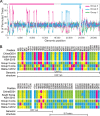Origin and Possible Genetic Recombination of the Middle East Respiratory Syndrome Coronavirus from the First Imported Case in China: Phylogenetics and Coalescence Analysis
- PMID: 26350969
- PMCID: PMC4600111
- DOI: 10.1128/mBio.01280-15
Origin and Possible Genetic Recombination of the Middle East Respiratory Syndrome Coronavirus from the First Imported Case in China: Phylogenetics and Coalescence Analysis
Abstract
The Middle East respiratory syndrome coronavirus (MERS-CoV) causes a severe acute respiratory tract infection with a high fatality rate in humans. Coronaviruses are capable of infecting multiple species and can evolve rapidly through recombination events. Here, we report the complete genomic sequence analysis of a MERS-CoV strain imported to China from South Korea. The imported virus, provisionally named ChinaGD01, belongs to group 3 in clade B in the whole-genome phylogenetic tree and also has a similar tree topology structure in the open reading frame 1a and -b (ORF1ab) gene segment but clusters with group 5 of clade B in the tree constructed using the S gene. Genetic recombination analysis and lineage-specific single-nucleotide polymorphism (SNP) comparison suggest that the imported virus is a recombinant comprising group 3 and group 5 elements. The time-resolved phylogenetic estimation indicates that the recombination event likely occurred in the second half of 2014. Genetic recombination events between group 3 and group 5 of clade B may have implications for the transmissibility of the virus.
Importance: The recent outbreak of MERS-CoV in South Korea has attracted global media attention due to the speed of spread and onward transmission. Here, we present the complete genome of the first imported MERS-CoV case in China and demonstrate genetic recombination events between group 3 and group 5 of clade B that may have implications for the transmissibility of MERS-CoV.
Copyright © 2015 Wang et al.
Figures




Comment in
-
Middle East Respiratory Syndrome Coronavirus Recombination and the Evolution of Science and Public Health in China.mBio. 2015 Sep 8;6(5):e01381-15. doi: 10.1128/mBio.01381-15. mBio. 2015. PMID: 26350973 Free PMC article. No abstract available.
References
-
- Guery B, Poissy J, el Mansouf L, Séjourné C, Ettahar N, Lemaire X, Vuotto F, Goffard A, Behillil S, Enouf V, Caro V, Mailles A, Che D, Manuguerra JC, Mathieu D, Fontanet A, van der Werf S, MERS-CoV Study Group . 2013. Clinical features and viral diagnosis of two cases of infection with Middle East respiratory syndrome coronavirus: a report of nosocomial transmission. Lancet 381:2265–2272. doi:10.1016/S0140-6736(13)60982-4. - DOI - PMC - PubMed
-
- De Groot RJ, Baker SC, Baric RS, Brown CS, Drosten C, Enjuanes L, Fouchier RA, Galiano M, Gorbalenya AE, Memish ZA, Perlman S, Poon LL, Snijder EJ, Stephens GM, Woo PC, Zaki AM, Zambon M, Ziebuhr J. 2013. Middle East respiratory syndrome coronavirus (MERS-CoV): announcement of the Coronavirus Study Group. J Virol 87:7790–7792. doi:10.1128/JVI.01244-13. - DOI - PMC - PubMed
-
- Memish ZA, Mishra N, Olival KJ, Fagbo SF, Kapoor V, Epstein JH, AlHakeem R, Durosinloun A, Al Asmari M, Islam A, Kapoor A, Briese T, Daszak P, Al Rabeeah AA, Lipkin WI. 2013. Middle East respiratory syndrome coronavirus in bats, Saudi Arabia. Emerg Infect Dis 19:1819–1823. doi:10.3201/eid1911.131172. - DOI - PMC - PubMed
Publication types
MeSH terms
Substances
Associated data
- Actions
LinkOut - more resources
Full Text Sources
